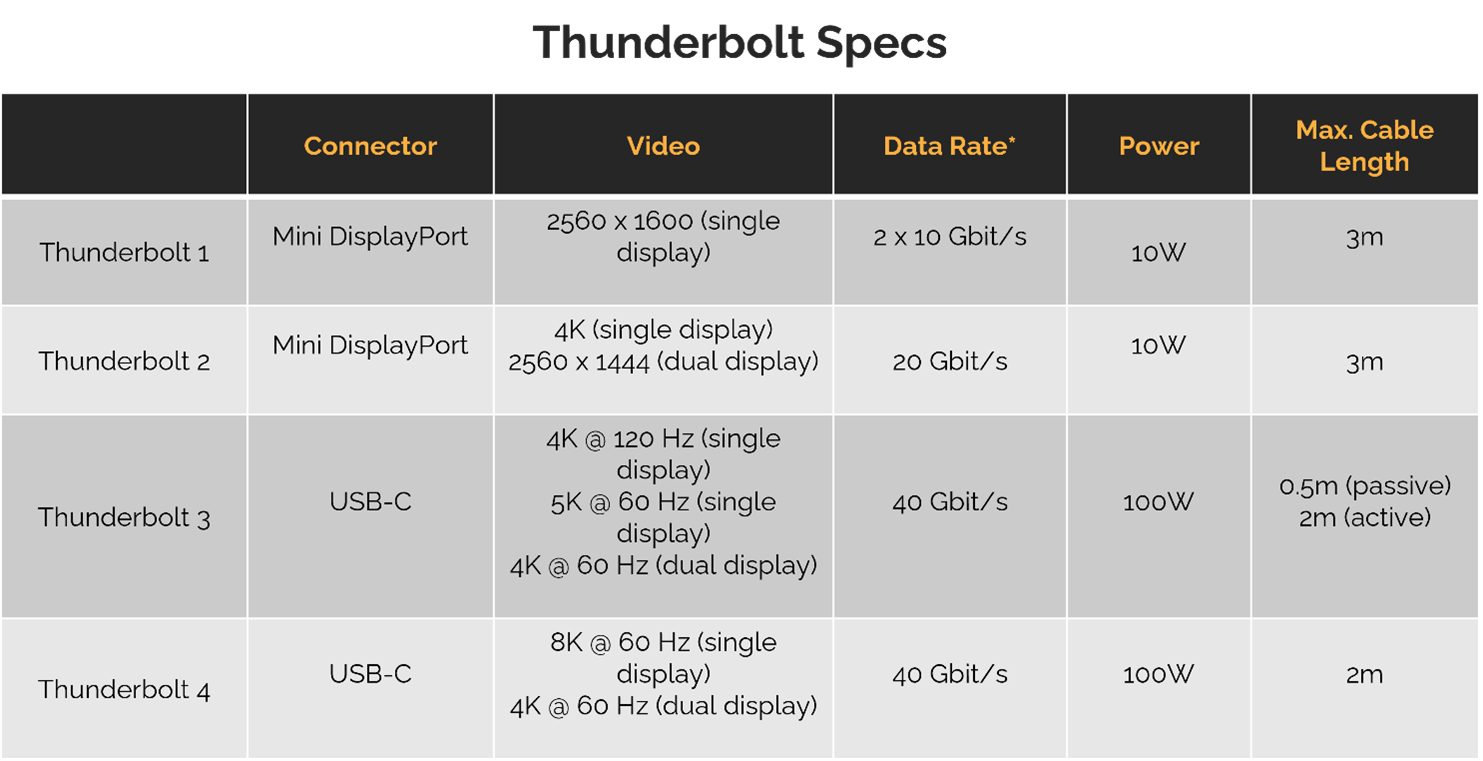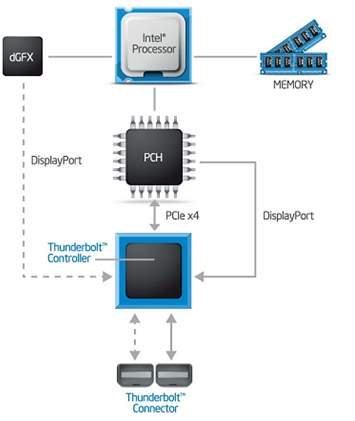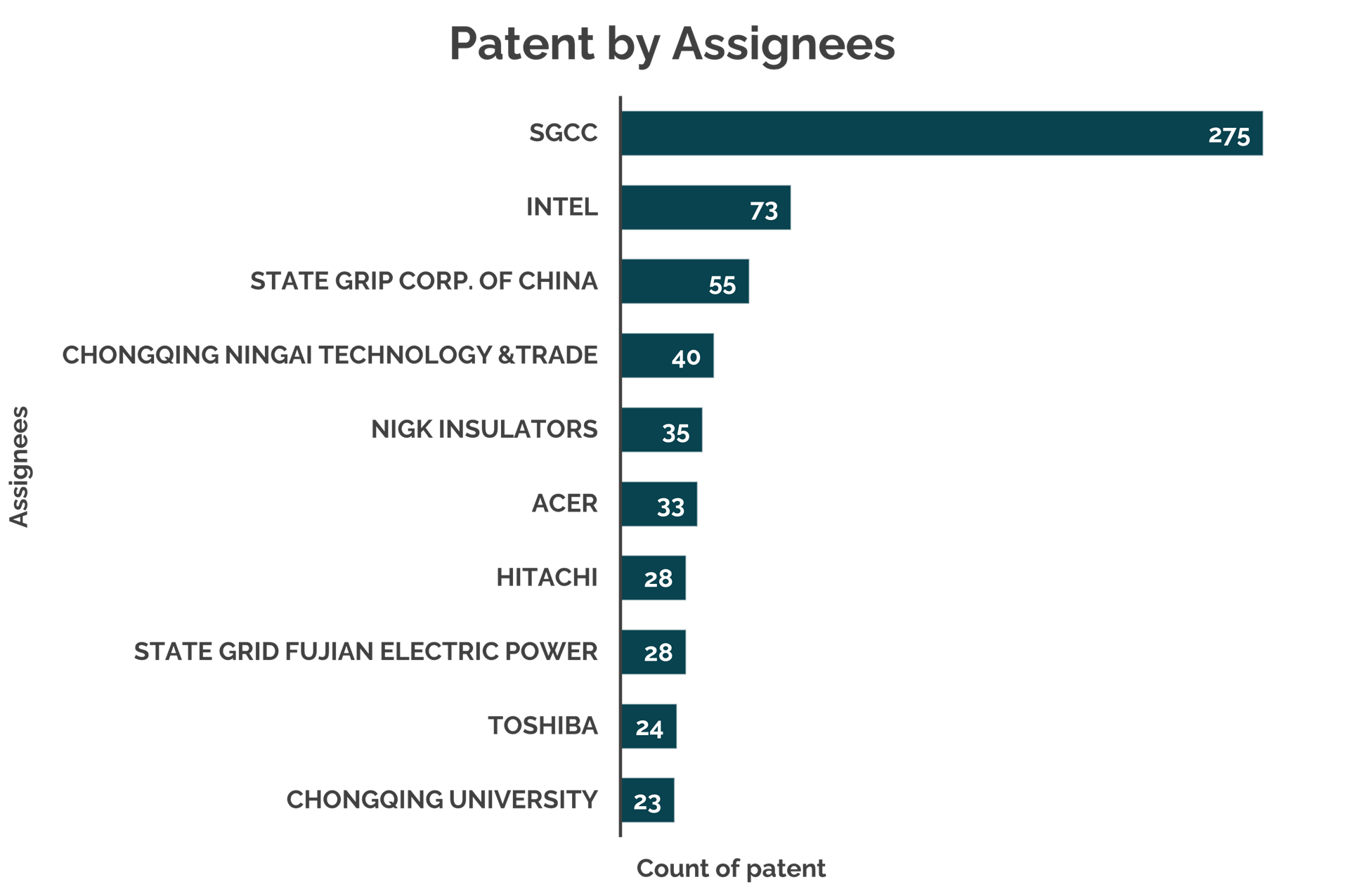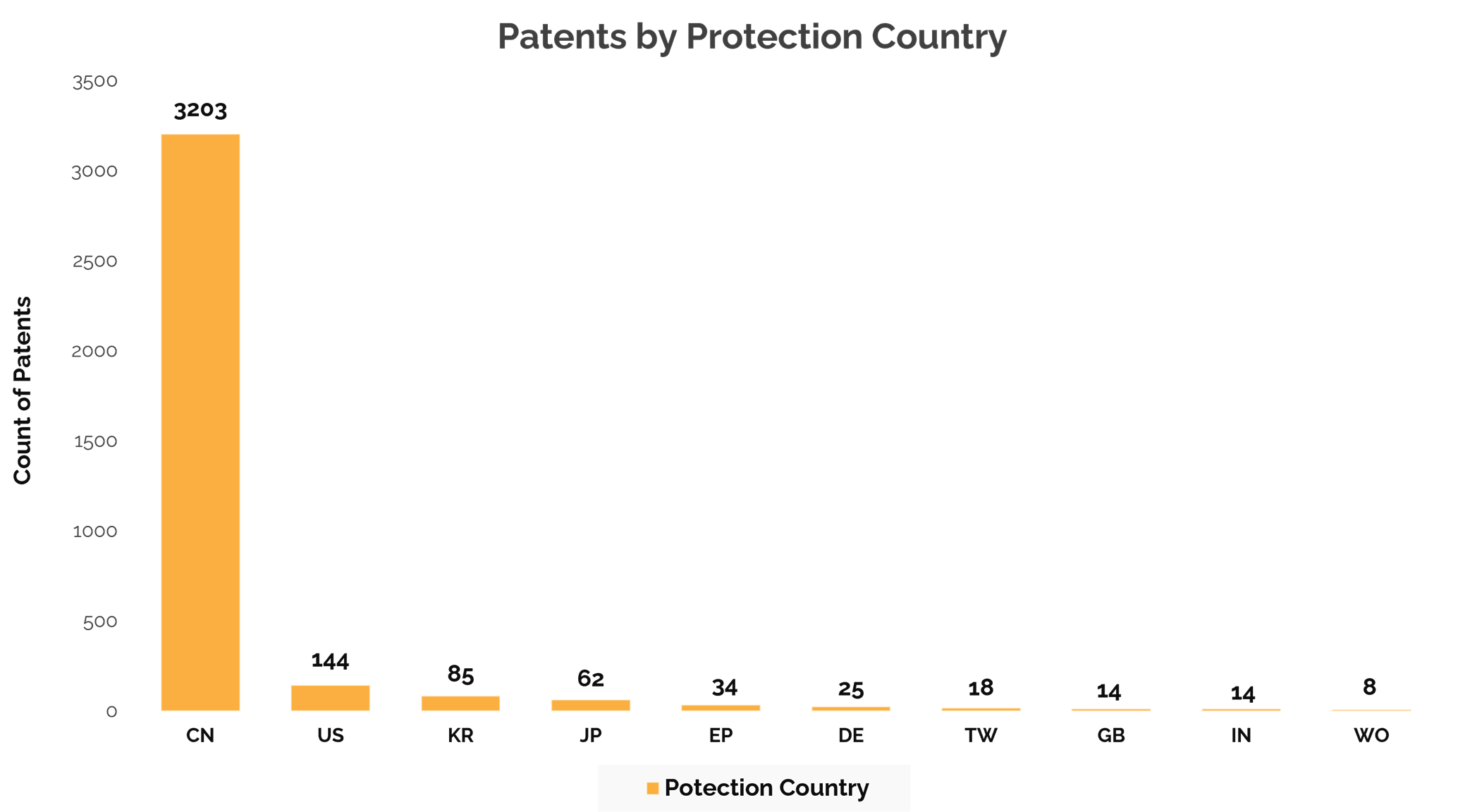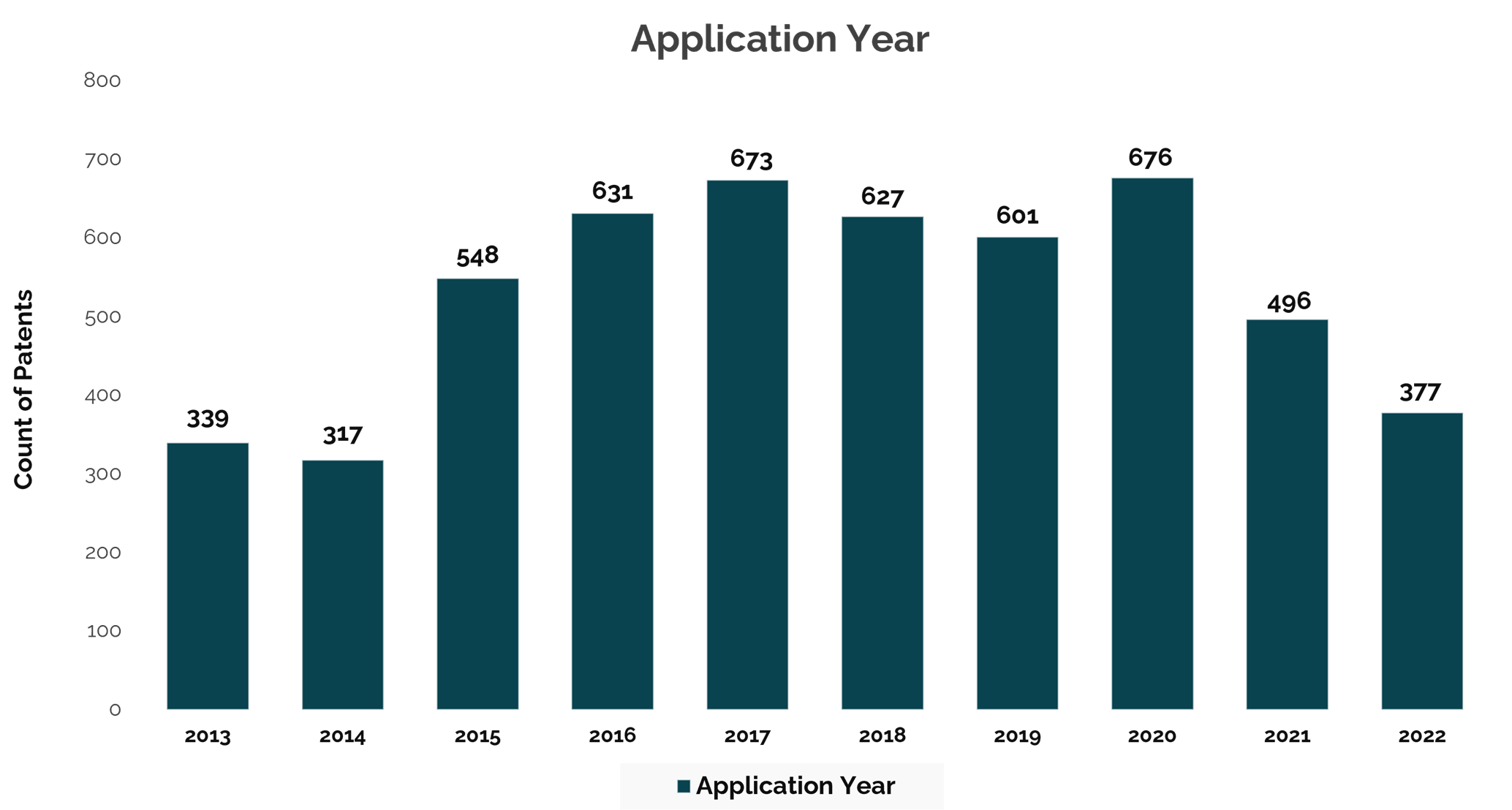Thunderbolt Interface
Thunderbolt is a high-speed input/output (I/O) technology developed by Intel that allows for fast data transfer and video streaming over a single cable. Thunderbolt Interface is a hardware interface used for the connection of various external peripherals for fast data transfer between a computer and the various attached peripherals. It supports multiple types of I/O devices, including displays, external storage devices, and network adapters. It uses a PCI Express (PCIe) connection to provide high-speed data transfer and DisplayPort to support video output.
Fig. 1 Thunderbolt Interface
There are five generations of Thunderbolt Interface - Thunderbolt 1,2,3,4 and 5.
Thunderbolt 1: It was the first version used, having a maximum data transfer of 10 Gbps (gigabits per second) and was first mainly featured in Apple devices and supported the Mini DisplayPort connector, which is a miniaturized and less common version of the DisplayPort audio-visual digital interface.
Thunderbolt 2: It was the second version used, having a maximum data transfer of 2*10 Gbps (gigabits per second), having a Mini DisplayPort connector, and supporting channel aggregation, which refers to combining the two channels into one channel, for example, combining the two 10 Gb/s channels into one 20 Gb/s channel.
Thunderbolt 3: It was the third version used, having a maximum data transfer of 4*10 Gbps (gigabits per second) and used 64b/66b encoding (i.e., transforming 64-bit data to 66-bit line code to allow reasonable clock recovery and alignment of the data stream at the receiver). It uses a power consumption of 100 W and video resolution of 4K and 5K.
Thunderbolt 4: It is a "superset standard" incorporating USB 4.0 standards. It uses a power consumption of 100 W and a video resolution of 4K and 8K. The detailed Thunderbolt specs difference is discussed in Fig.2 below-:
Fig. 2 Types of Thunderbolt
(Source 1)
Pinout
As the Thunderbolt has two bitrates i.e. 10 Gbit/s each (20 Gbit/s in total)
Thunderbolt 1 and 2 Pinout is different from Thunderbolt 3 and 4. Thunderbolt 1 and 2 Pinout is shown in the figure below-:
Fig. 3 Thunderbolt 1 and 2 Pinout
The pins are classified as HS0TX/HS0RX and LSR2PTX/RX depicting the different speed transmit rates. The high-speed transmit (HS0TX) indicates transmit rate of about 480 Mbps, whereas the low-speed transmit (LSR2PTX) indicates transmit rate of about 1.5 Mbps.
Thunderbolt 3 and 4 Pinout is shown in figure below:
Fig. 4 Thunderbolt 3 and 4 Pinout (Source 2)
Thunderbolt 3 and 4 Pinout has SuperSpeed pins. It depicts a very high transfer rate of about 5-10Gbps, which is more than the HS0TX+ pin present in Thunderbolt 1 and 2 Pinout. The Side Band Uuse (SBU) is not for USB but is open for Alternate modes, such as DisplayPort over Type-C, which allows transferring data/video via multiple interfaces.
Thunderbolt Protocol Architecture
Thunderbolt is a high-speed input/output (I/O) interface protocol that was developed jointly by Intel and Apple in 2011.
Fig. 5 Thunderbolt Protocol Architecture
The Thunderbolt interface protocol architecture is based on a combination of two key technologies: PCI Express (PCIe) and DisplayPort. These technologies are used to provide fast data transfer rates and support for multiple types of I/O devices.
At its core, Thunderbolt uses a PCIe connection to provide high-speed data transfer. PCIe is a high-speed serial computer expansion bus standard that is used to connect devices to a computer's motherboard. By using PCIe, Thunderbolt can provide fast data transfer rates of up to 40 Gbps.
In addition to PCIe, Thunderbolt also supports DisplayPort, which is a digital display interface standard used to connect a video source to a display device. Thunderbolt uses DisplayPort to support video output, which means that a single Thunderbolt port can be used to connect both display and non-display devices.
The Architecture consists of layers, as shown in Fig.5, which are the transport layer, optical layer, and connector/cable(physical layer). The heart of the thunderbolt architecture is the transport layer.
The Thunderbolt protocol physical layer is responsible for link maintenance, including hot-plug detection and data encoding, to provide highly efficient data transfer. The physical layer has been designed to introduce very minimal overhead and provides full 10Gbps of usable bandwidth to the upper layers. It may be electrical or optical. The transport layer has a high-performance, low-power switching architecture. A highly efficient, low-overhead packet format with flexible QoS support that allows multiplexing of bursty PCI Express transactions with isochronous DisplayPort communication on the same link. A time synchronization protocol that allows all the Thunderbolt products connected in a domain to synchronize their time within 8ns of each other. The Thunderbolt cables are either electrical or optical and use the same Thunderbolt connector. An active electrical-only cable provides for connections of up to 3 meters in length and provides for up to 10W of power deliverable to a bus-powered device.
And an active optical cable provides for much greater lengths of up to 50m but does not provide power for bus-powered devices.
Fig. 6 Thunderbolt controller
A Thunderbolt controller is the building block used to create Thunderbolt products. A Thunderbolt controller is a hardware component that enables Thunderbolt connectivity on a device. A Thunderbolt controller contains:
A high-performance, Thunderbolt protocol switch
One or more Thunderbolt ports
One or more DisplayPort protocol adapter ports
A PCI Express switch with one or more PCI Express protocol adapter port
The external interfaces of a Thunderbolt controller that are connected to a system depend on the application for which the system is designed. An example implementation of a host-side Thunderbolt controller is shown in Figure 6.
Host-side Thunderbolt controllers have one or more DisplayPort input interfaces, a PCI Express interface, along with one or more Thunderbolt technology interfaces. By integrating all the features necessary to implement Thunderbolt into a single chip, the host-side controller enables system vendors to easily incorporate Thunderbolt technology into their designs.
A Thunderbolt controller typically includes a PCIe interface for connecting to the host device's motherboard, as well as a DisplayPort interface for video output. It also provides power delivery and USB connectivity, allowing for a variety of devices to be connected through a single Thunderbolt port.
Thunderbolt controllers can be found on a variety of devices, including laptops, desktops, and external hard drives. They are typically designed to support multiple Thunderbolt ports, allowing users to connect multiple devices at once.
In addition to its high-speed data transfer capabilities, Thunderbolt also supports daisy-chaining, which allows multiple devices to be connected in a chain and controlled by a single Thunderbolt port. This makes it a popular choice for professionals who require fast data transfer speeds and the ability to connect multiple devices simultaneously.
IP Landscape/IP Moats
As observed from Fig. 7, the top assignees related to the thunderbolt interface/ technology are SGCC-State Grid Corporation of China, Intel, Chongqing Ninglai Technology and Trade, NGK Insulators, and Acer. It is also noted that the country having the maximum number of patent assignees is China, followed by the USA and South Korea, as shown in Fig.8.
Fig. 7 Top Patent Assignees of Thunderbolt
Fig. 8 Patent Filing Statistics of Thunderbolt
Fig. 9 Application Year
From the last ten year’s patent filing activities, it is observed that the maximum number of patent filings (676) was done in the year 2020, followed by the year 2017 and 2016.
Fig.10 Geographical Distribution
The top market and competitors’ location is China followed by the US, Korea and Japan.
Thunderbolt technology is now widely used to provide high-speed data transfer. Thunderbolt Technology has a wide variety of use cases in various fields, such as Docking Stations, External Storage, External Graphics, Display Connectivity, streaming, and Daisy Chain / Hub.
Conclusion
To sum up, our exploration of the Thunderbolt interface has provided a comprehensive understanding of its evolution over five generations. We've delved into its pinout configuration, unraveling the intricate wiring that enables its high-speed data transfers and versatile capabilities. The Thunderbolt protocol architecture has been unveiled as the foundation for seamless device communication, underscoring its role in powering various functionalities. Our analysis of patents related to Thunderbolt has shed light on the innovative strides taken in its development, highlighting the collaborative efforts and ingenuity behind its evolution.
In essence, Thunderbolt has emerged as a pivotal player in modern connectivity. Its adaptability across generations and compatibility with different standards showcase its versatile nature. From enabling rapid data transfers to facilitating video transmission, Thunderbolt has woven itself into the fabric of contemporary computing and device interconnectivity. Looking ahead, Thunderbolt's journey continues, with each iteration promising new innovations and applications. As technology advances, Thunderbolt remains positioned to reshape industries and enhance digital experiences, all while maintaining its role as a crucial thread in the intricate tapestry of technological progress.
Disclaimer: This report is based on information that is publicly available and is considered to be reliable. However, Lumenci cannot be held responsible for the accuracy or reliability of this data.
Disclaimer: This report is based on information that is publicly available and is considered to be reliable. However, Lumenci cannot be held responsible for the accuracy or reliability of this data.
Editorial Team at Lumenci
Through Lumenci blogs and reports, we share important highlights from the latest technological advancements and provide an in-depth understanding of their Intellectual Property (IP). Our goal is to showcase the significance of IP in the ever-evolving world of technology.



